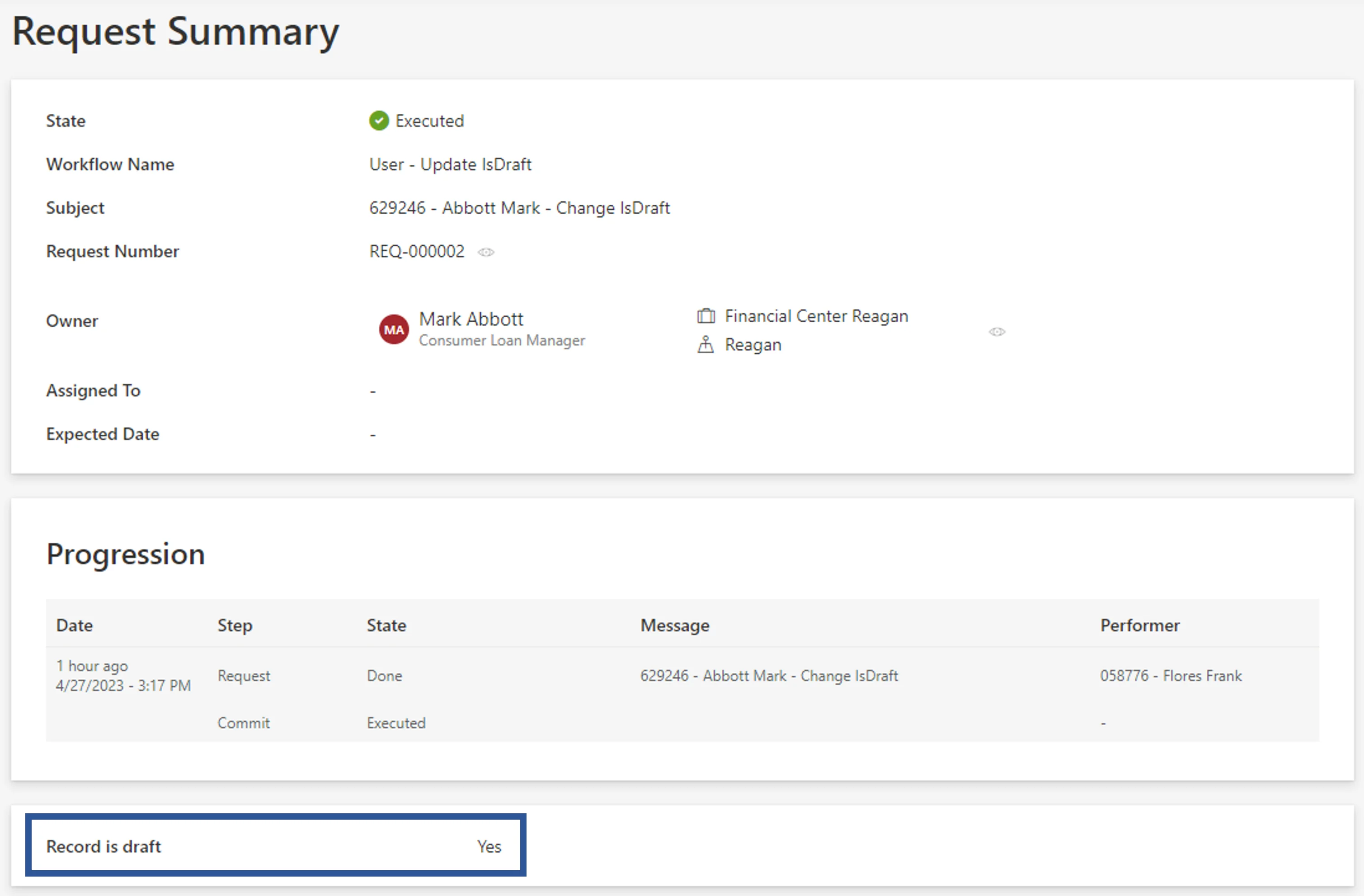For Resource Update (No Record)
This section guides you through the procedure for the creation of a workflow to update a simple resource, i.e. to update, within a given resource, properties that do not involve records.
Declare a Workflow
This workflow is made of two activities:
ActionWithRefine: sends the resource's update request with a possibility of delegation.Persist: saves the collected data and triggers provisioning.
The example below creates a workflow to update only the user's IsDraft attribute.
<Workflow Identifier="Directory_User_ChangeIsDraft" DisplayName_L1="User - Update IsDraft" VariablesType="Workflow_Directory_User"> <Activity Identifier="Request" DisplayName_L1="Request" Template="ActionWithRefine" /> <Activity Identifier="Persist" DisplayName_L1="Commit" Template="Persist" /></Workflow>
Create Forms
The XML configuration below represents the creation of a form that defines the elements to display in the workflow.
Here we just have one field called IsDraft to update the corresponding boolean attribute for a
given user:
<Form Identifier="Workflow_Directory_User_ChangeIsDraft_Base" EntityType="Workflow_Directory_User"> <Control DisplayName_L1="IsDraft" OutputType="LayoutRowset" EntityType="Directory_User"> <Control Binding="IsDraft" /> </Control></Form>
Link the Forms to the Workflow
After creating a workflow with given activities, it is necessary to create the form to be displayed
when launching the workflow. It has the type corresponding to a resource's update, i.e.
WorkflowEditEntityForm and it must specify the workflow's context (the entity type of the involved
resources, the main property, the activity when the form is called, etc.
see more details):
<WorkflowEditEntityForm Identifier="Workflow_Directory_User_ChangeIsDraft" EntityType="Workflow_Directory_User" MainProperty="Workflow_Directory_User:Directory_User" WorkflowRequestType="Self" Activity="Directory_User_ChangeIsDraft:Request" HideRoles="true" FormTitle_L1="Change IsDraft"/>
A WorkflowEditEntityForm requires one child element MainControl that defines the actual content
of the workflow's form and calls the form created previously:
<WorkflowEditEntityForm Identifier="Workflow_Directory_User_ChangeIsDraft" EntityType="Workflow_Directory_User" MainProperty="Workflow_Directory_User:Directory_User" WorkflowRequestType="Self" Activity="Directory_User_ChangeIsDraft:Request" HideRoles="true" FormTitle_L1="Change IsDraft">
<MainControl OutputType="TransformImport" EmbeddedForm="Workflow_Directory_User_ChangeIsDraft_Base" />
</WorkflowEditEntityForm>
Add a summary (Optional)
Another child element SummaryControl can be added to insert a summary part, i.e. the form used
after the workflow execution to show some values, most of the time those affected by the workflow,
typically the properties editable in the workflow or generated properties. So in our situation, it
displays the IsDraft attribute that the user just changed:
<WorkflowEditEntityForm Identifier="Workflow_Directory_User_ChangeIsDraft" EntityType="Workflow_Directory_User" MainProperty="Workflow_Directory_User:Directory_User" WorkflowRequestType="Self" Activity="Directory_User_ChangeIsDraft:Request" HideRoles="true" FormTitle_L1="Change IsDraft"> <MainControl OutputType="TransformImport" EmbeddedForm="Workflow_Directory_User_ChangeIsDraft_Base" />
<SummaryControl OutputType="LayoutContainer" EntityType="Directory_User"> <Control Binding="IsDraft" /> </SummaryControl>
</WorkflowEditEntityForm>

Assign the Right Permissions
Some profiles must get specific permissions so that the workflow is visible and usable by the right users. Read about workflows' permissions.
Below is an example of an access control rule where the Administrator profile gets the permissions
for the whole update request from the previously created workflow:
<AccessControlRule Profile="Administrator" EntityType="Workflow_Directory_User" Identifier="Administrator_Workflows_Directory_User_Internal*" DisplayName_L1="Administrator_Workflows_Directory_User_Internal*"> <Entry Permission="/Custom/Workflows/Directory_User_ChangeIsDraft/Request/ActionPending" CanExecute="true" /> <Entry Permission="/Custom/Workflows/Directory_User_ChangeIsDraft/Request/RefinePending" CanExecute="true" /> <Entry Permission="/Custom/Workflows/Directory_User_ChangeIsDraft/Request/Aborted" CanExecute="true" /> <Entry Permission="/Custom/Workflows/Directory_User_ChangeIsDraft/Request/Purged" CanExecute="true" /></AccessControlRule>
Create Menu Items in the UI
Menu items must be defined to make the workflow accessible in the UI.
Updating an existing resource, this workflow manages one given resource at a time. Hence an interesting location for this workflow could be the individual view page of users.

To create a menu item here for the new workflow, you can add the following XML configuration to the existing menu items list:
<MenuItem Identifier="Menu_Directory_User" DisplayName_L1="Menu"> <MenuItem Identifier="Menu_Directory_User_Changes" DisplayName_L1="Actions"> <MenuItem Identifier="Menu_Directory_User_Changes_Update" DisplayName_L1="Section"> ...
<MenuItem Identifier="Menu_Directory_User_Changes_ChangeIsDraft" DisplayName_L1="Change IsDraft" IconCode="Edit" Workflow="Directory_User_ChangeIsDraft" />
</MenuItem> </MenuItem></MenuItem>
Add Aspects
For each workflow, it is possible to add aspects according to the workflow's purpose.
Customize the Display Table (Optional)
To configure a display table different from the default one provided by Usercube, read how to configure a display table.